|
TennisOne Lessons The Role of the Wrist in the Forehand, Revisited
You may have heard teaching pros say, "Never use your wrist in a groundstroke, particularly the forehand." In fact, for many years all of our data pointed to the conclusion that touring pros do not use their wrist when hitting the forehand. A close examination of available video of players in match action seems to confirm this because it is not easy to detect evidence of wrist movement in the forehand videos of top players. However, in this article we explain that the wrist is used by touring pros when hitting forehands. Further we explain how this is done, and because this is a controversial topic, we explain why it is so difficult to confirm this from video. This article is organized into three sections. Section one explains the problem in using video to detect a wrist movement. Part two explains how the wrist moves, and part three explains how the wrist is used in conjunction with the other elements of motion that produce ball speed. Detecting Wrist Movement in Videos Most video is not sufficient to prove or disprove the use of the wrist in a professional player's forehand. This may seem self evident to some, but not being able to see the wrist movement in video does not exclude its presence. Here is why. In order to accurately measure the wrist movement we need a frame rate that can resolve the motion in units of 1/10 of and inch. If the arm if a point on the hand is moving at 30mph, this equates to 44 feet per second or 528 inches per second. Each frame must record 1/10 of this motion giving a frame rate of over 5000 frames per second. If we only require 4 measurements per inch of movement we get a frame rate of over 2,000 frames per second (not at all out of reach for today's technology).
However, in addition to a high frame rate, each frame must have the ability to clearly and accurately resolve the image in fractions of an inch, preferably 1/10 of an inch. Thus while we can get a frame rate of 2,000fps, the resolution of each frame may be very grainy. Thus 2,000 fps frame rate with clear 1/10th of an inch resolution is harder to obtain. The setup is also important. The camera must be placed overhead and the player must be standing on a grid resolved into units of 1/10 of an inch. Also, the the player must be standing still at ball impact. This arrangement will minimize the chances for error. Following this we will need, using small sampling theory, about 40 distinct samples to analyze. The analysis may require very high quality pattern recognition software as well. In short, it will be very hard to establish the use of the wrist by professional players using video alone without some luck. Thus additional measurements are needed. To address this problem we combined the use of conventional 30 fps video at an exposure rate of 1/500 of a second with state-of-the-art doppler radar, plus a component analysis. In order to overcome the problems with directly measuring the presence of wrist movement, we decided on what is known as a Bayesian approach. This means that we sought to find the most probable cause/explanation of the resulting ball speed. We started by individually analyzing the components (legs, hips, shoulder rotation, shoulder punch, etc. ) of racquet head speed with video. The components in isolation can only produce a velocity of around 15 mph, thus cutting our accuracy requirements in half. Also, the grid needed to measure a component is far simpler than that needed for a body in motion. Further, the component measurements were made in a studio setting with a grid using a frame rate of 30 frames per second with a shutter speed of 1/500 of a second. Lastly, we were not trying to measure the movement of the wrist, but only the speed it could produce, a far simpler problem.
Note that by obtaining multiple controlled samples (over 30), we can push the effective sampling rate to over 1000 samples per second with a camera that produces only 30fps so long as they are performed with the same registration system. By summing the separate components we are able to determine a "theoretical" maximum racquet head speed of a forehand. Second, we collected a large set of samples of professional players at WTA satellite and challenger level tournaments in practice sessions where they started a rally by dropping a ball and striking it. This set of data samples showed that, typically, the lead off speed is about 50mph. This suggests a racquet speed of about 33mph using data from Brody's experiments at the University of Pennsylvania. Combining all relevant sources of racquet speed except the wrist and using a Bayesian probability analysis, 33mph is an expected racquet head speed under these conditions. This figure was further corroborated by controlled studio experiments. In November, we covered the WTA tour Advanta event measuring both the qualifying and main draw players using video and doppler radar. While most players in the qualifying produced 50mph lead off ball speeds in agreement with our data, one consistently produced 60mph lead off speeds completely contradicting the results of our average data set. We returned to the drawing board and began looking for the source of this extra speed (about 7mph) and found that the only remaining source of such speed was in the wrist. We set up controlled experiments and verified that that by using the wrist, one could generate exactly the needed extra racquet speed to account for this difference. However, using the wrist seemed very risky to hit a professional shot especially since the time to correct any part of the motion of the racquet near the strike zone is nowhere nearly that needed to be accurate. Thus we began to investigate how this might be possible. After some time we finally worked out a theory and then proved it on the court. The result is that the wrist can be used effectively to hit a consistent and accurate forehand at high speeds. The only remaining issue is to explain how this is done so that teaching pros can convey this idea accurately to their students. Before we explain how this is done we provide the following disclaimer. Caution: using the wrist improperly can lead to tendonitis or other injuries. We present this data for informational purposes only and cannot be responsible for misuse or injuries resulting from the student's actions or experimentation using the wrist. How is the wrist used in a professional forehand?
Any theory of the wrist movement must overcome three problems: (1) How do you initiate the wrist movement. (2) How is the movement translated into a straight line to assure the racquet will strike "through the path of the ball". (3) How is the wrist movement combined with the other sources of racquet head speed (rotational movements such as upper arm rotation, shoulder rotation, or hip rotation) so that the combined movement is stable and accurate. First, we determined that the wrist movement, to be effectively initiated, requires that the wrist be laid back as far as possible at the start of the stroke and held back until the other acceleration movements are completed. Also we determined that the wrist must not break beyond the line from the elbow to the hand if it is to be consistent. From this and other data we determined that when the wrist movement is complete, the wrist configuration will look as seen in figure 1, for a western grip. As to the second specification,assuring that the racquet head will go straight through he path of the ball we determined by a geometric analysis that if we superimpose two circular movements, the result can be a nearly straight line movement even though any circular movement used in isolation remains circular and will be a high risk movement for a tennis stroke. This explains why the wrist can be used safely at medium speeds. However, when the racquet enters the 4 to 8 inch strike zone, the entire motion of the racquet must be completely straightened out so that the racquet makes clean contact with the ball. This is where the element of timing and skill come into play. This may require a combination of forearm extension, shoulder extension, and "leaning forward" into the ball all carefully timed to occur during the strike zone. Caution: the wrist movement must be completed before the ball strikes the racquet to avoid the possibility of injury. By obtaining a large set of video samples we managed (just by luck) to find two consecutive frames that illustrate the use of the wrist. The frames are presented above and are 1/30 seconds apart. The player we videoed can control an 80mph forehand under match conditions. She has a western grip. By close inspection of the two frames one can see that the relationship between the palm of the hand in the second frame has changed significantly from that of the first frame. In the Figure 4 below, we have recreated this difference in the studio, photographed from overhead. How is the wrist used in conjunction with other movements?
The wrist must be used in conjunction with other movements as part of the kinetic chain. For example:
Net Drill To develop this movement, try standing by the net (stand as far back as you would if the ball were in the same position as the net) and striking it in a manner so that the entire face of the racquet contacts the net at the same time. Typically, the top of the racquet will contact the net first. This is not what you want. You must repeat this exercise until you can execute the strike at a high speed. Caution: you will have to keep the racquet head lower than your hand to avoid hitting your hand on the net when you practice. We have filed a patent on a device to measure the efficiency of a stroke during this exercise which will be available in the near future. Your comments are welcome. Let us know what you think about Ray and Becky Brown's article by emailing us here at TennisONE.
Ray and Becky Brown are the founders of EASI TennisTM. The EASI TennisTM System is a new and revolutionary method of teaching stroke technique that can dramatically reduce the time needed to learn to play master, or any level, of tennis. To learn more about the EASI TennisTM System, click here.
|

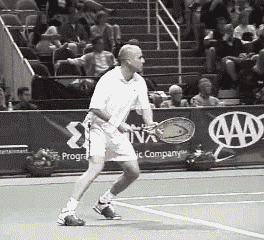
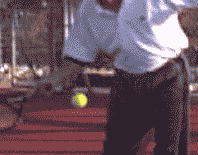
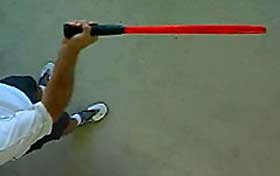
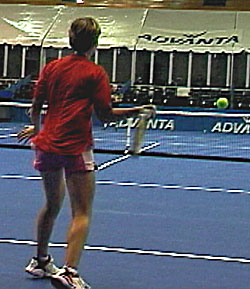
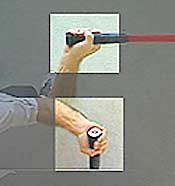
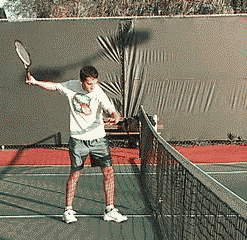
 Ray Brown, Ph.D.
Ray Brown, Ph.D.